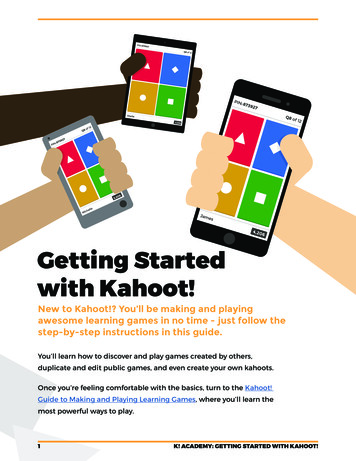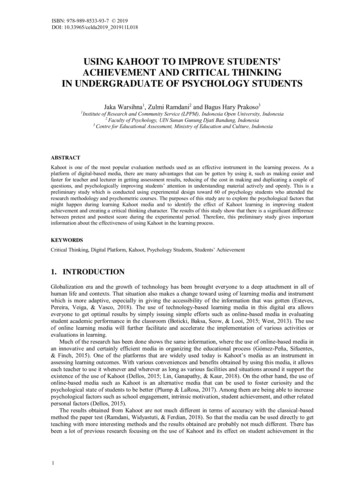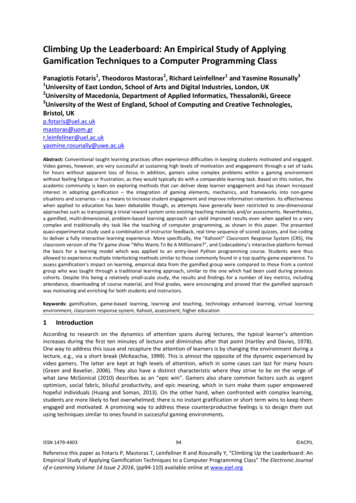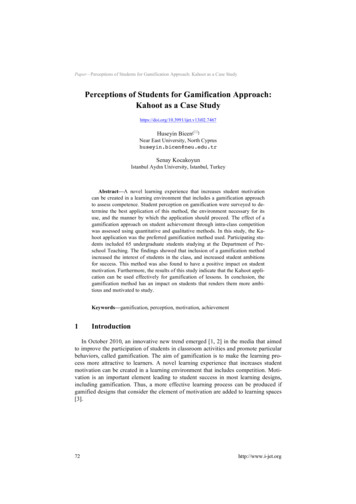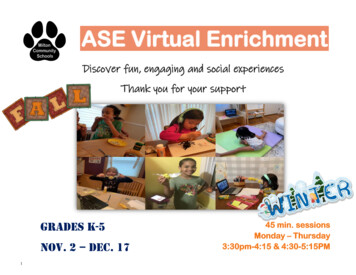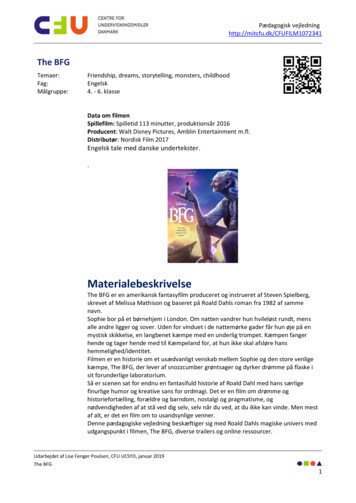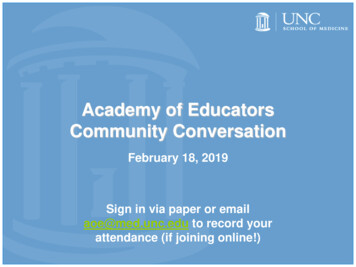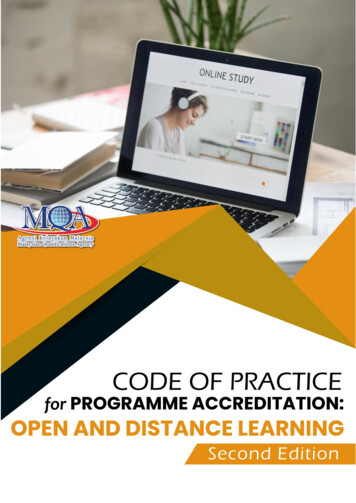
Transcription
LEARNING IS A KAHOOT! A LOOK AT ENGAGEMENT ANDITS EFFECT ON ASSESSMENT DURING THE COVID-19PANDEMICBYALEXANDER STAHLTHESISSubmitted in partial fulfillment of the requirementsfor the degree of Mater of Science inComputer and Information ScienceUniversity of Michigan – Flint, 2021Flint, MIFirst ReaderDr. Matthew SpradlingSecond ReaderDr. Mark Allison
ABSTRACTIn response to the global pandemic, COVID-19, remote learning has become increasinglynecessary. To assist in memory retention in education, teachers can use video games as a tool forinteractive learning. This paper details a preliminary study examining the use of competitivevideo games as an interactive learning tool, designed to measure students’ level of engagement.Through the use of Kahoot!, we compare short-term learning outcomes for groups of college anduniversity students. We compare students’ outcomes based upon their level of interaction withthe game-based learning tool. In this study we developed assessments to coincide with theKahoot! and followed each assessment with student surveys. Key findings show that Kahoot!enhanced the level of interaction and showed promising results for improving assessment scores.
DEDICATIONDedicated to all teachers during this pandemic.
ACKNOWLEDGEMENTSMy wife, Kayla, without whom, this would not be possible.Dr. Spradling, for never giving up on me.My family and friends, for supporting me along the way.
TABLE OF CONTENTS1. INTRODUCTION2. RELATED WORK3. MOTIVATION: EYES OF ENGAGEMENT3.1GOAL ORIENTATION3.2STUDENT MOTIVATION3.3TOM MALONE’S THEORY ON MOTIVATION4. REWARD BASED LEARNING5. ON THE SUBJECT OF LIMITED CLASS TIME6. ASSUAGING FEARS ABOUT GAMIFICATION IN THE CLASSROOM7. LOGISTICS8. METHODOLOGY8.1CREATING THE KAHOOT!8.2THE PRE AND POST TESTS8.3LET’S PLAY KAHOOT!8.4THE CONTROL STUDY8.5THE FOLLOW-UP SURVEY9. RESULTS10. FURTHER RESEARCH OPPORTUNITIES11. CONCLUSION12. BIBLIOGRAPHY
INTRODUCTIONThe COVID-19 pandemic that triggered lockdowns in early 2020 created new challengesfor educators. Class lectures that were primarily face to face, sharply transitioned to onlineremote learning, that left many teachers with little time to prepare. In a completely online format,this compounds on both the educator and the student, who have lost the ability to communicatenon-verbally in the classroom. To mitigate the loss of having students in a physical classroom,educators needed to find new ways of connecting with students and keeping their attention in avirtual classroom.One way to manage this is through an online game called Kahoot!. Kahoot! is aninteractive game that can be used as a learning tool for reviewing any concept that the educatorwants their students to know. This study is meant to test the effects of student engagement onassessment through the use of game-based learning. Here, we are defining engagement inaccordance with the Australasian Survey of Student Engagement (AUSSE). AUSSE has sixengagement scales: academic challenge, active learning, interactions, enriching educationalexperiences, supportive learning environment, and work-integrated learning. (Coates, 2010) Ourstudy tests these six engagement scales through comparing active participation in game-basedlearning against passive participation though watching the game. We seek to demonstrate thatengagement as defined by AUSSE is necessary towards increasing student engagement and thatstudent engagement is a necessary component in higher assessment scores. In this paper, wediscuss the methodology for the study using Kahoot! and the challenges of performing said studyin a global pandemic. We will then quantify engagement and determine how reward-basedlearning, goal orientation, socio-cultural motivation, and psychological motivation paint a picture
of each individual student. Finally, we try to assuage fears about gamification in the classroomand then conclude by identifying areas of further research.RELATED WORKThere are several examples of games being used to teach work-related concepts. In theclassroom, a school teacher used Multiplayer Educational Gaming Applications or (MEGAs) toteach her science class about genetics. The MEGA was introduced to the students as a review ofgenetics material covered and all 129 students received normal instruction prior to playing thegame. The experimental group played the MEGA and the comparison group reviewed thematerial via independent paper and pencil practice as well as whole group discussion. TheMEGA covered student understandings of pedigrees, Mendelian inheritance, blood types, andDNA fingerprinting through a problem-based crime scene investigative mystery. The meanreport card grades for both groups was not statistically significant, as both groups did about thesame on the exam with the control group edging out slightly. However, the experimental groupwas significantly more engaged than control group students. The researchers here found that thegame had a rich storyline but wasn't necessarily entirely skill-based, which may help to explainwhy results on their post-test weren't statistically better. However, the building and use ofMEGA's may be a worthwhile endeavor due to limited teaching methods on such concepts suchas genetics which are important for many science-based disciplines. The multiplayer componentof MEGAs allowed students to interrelate while interacting with the virtual environment makinggames more dynamic and interesting. This notion of cooperative play lends another dimension tolearning through games. (Annetta, 2009)
Another example is a medical professor who wanted to use Kahoot! to teach undergraduatemedical students histography and cell biology. She also wanted to test engagement and its effectson understanding the material. Four labs of about 50 students each participated via Zoom whilethe professor stood in a classroom with Kahoot! on a projector. All students participated in bothtraditional lab sessions and Kahoot! sessions to compare which they felt more engaged with andanswered a short questionnaire shortly after. An overwhelming majority of students reported thatthey felt that Kahoot! helped them learn the material better. (Kalleny, 2020) This studydifferentiates from mine in that I evaluated the participants with a pre and post-test, whereas shegave them a short questionnaire asking if they would like Kahoot! to be a review tool in theclassroom. Another key difference is her study compared traditional lecture with the Kahoot! viaZoom, whereas my study compares playing Kahoot! via Zoom and watching Kahoot! via Zoom.Exogenous games provide simple networks of generic, interactive strategies useful fororganizing access to a wide variety of content. They allow curriculum developers to quickly usethe skeleton of an existing game and formulate it to fit any subject matter. Exogenous gameshave the following attributes: they are an "empty receptacle, where the learner is motivated tolearn a new set of facts; the facts are "true" by the authority of the game designer; learners gainknowledge through memorization of a set of facts; instruction is taught by transmittinginformation effectively and "training" the right responses; the social model is dictated by theplayer acting alone and using outside resources is considered cheating; identity is meant to beboosted by the game developer, i.e. if the student is not motivated, it is the game developers jobto create an "exciting" learning environment; and finally the game must make learning palatable.Teachers and curriculum designers have long used exogenous games, such as Jeopardy-style orWheel of Fortune-style quizzes, to supplement a review of or a break from ordinary learning
activities. (Halverson, 2005) Examples of exogenous games include Jeopardy, Wheel of Fortune,and Kahoot!.MOTIVATION: EYES ON ENGAGEMENTYoung people’s intrinsic motivation towards games contrasts with their often-noted lackof interest in curricular contents (Prensky, 2003). Teachers have tried several methods to teachstudents in such a way that they will remember the content. One method that works well for ahistory class is movies, or short documentaries. By visualizing the subject matter, a student canimprint in their brain what is needed, so that instead of recalling information on a test fromlecture notes, they can recall information they learned from watching that video. Therefore,engagement is so important. Instead of the teacher teaching, they take on the role of a coach whois asking questions when necessary, while the students take a more active role.This is even more crucial at the university level. With COVID-19 and increased distancelearning, this problem is exasperated. This is where Kahoot! comes in, to increase studentengagement. To gauge engagement, we first need to understand what motivates a student. Wecan do this through a variety of perspectives, however here we are going to focus on thepsychological and socio-cultural perspectives.The psychological perspective is evident with the inclusion of the three dimensions ofengagement – affect, cognition, and behavior – as recommended by Fredericks, Blumenfeld andParis's (2004) comprehensive review. Affect is recognized as enthusiasm for the subject as wellas a sense of belonging to the institution. Cognition refers to being flexible with problem solving,finding a preference for hard work, and positive coping in the face of failure. Behavior concerns
the observance of rules and adhering to norms. A sense of belonging also points to the sociocultural perspective where the student sees themselves as part of the university, part of a major,or part of a line of work. A key strength of envisioning engagement in this way is that itacknowledges the lived reality of the individual, while not reducing engagement to just that.(Kahu, 2013) Because students are less likely to answer questions when the teacher asks foropen-ended discussion, we can see why. Some may not want to be seen as "drawing the lectureout", or "contributing to everyone else's boredom", so they stay silent even though they mighthave something to say. Kahoot! removes this socio-cultural pressure by allowing students tocreate a username and be as anonymous as they want to be. The teacher can then facilitate morediscussion after each question.Equally important to understanding a student's motivation is their goal orientation. Thereare two goal orientation beliefs: intrinsic and extrinsic. Students operating with an intrinsic goalorientation are assumed to be approaching a task with a focus on learning and mastery. Studentsoperating with an extrinsic goal orientation are assumed to be approaching the task with a focuson performance or grades or pleasing others. (Pintrich, 1992) We can work with both. Bothintrinsic and extrinsic students will have a vested interest in reaching the top three of the leaderboard. Having said this, we can assume that the answer to moving goal-oriented students iscompetition.There are some major advantages of competition in education through video games.Symmetrical social competitive gameplay is comparatively easy to include in a learning sessionthat contains educational videogames. In this variation of competition, each player has the sameresources and options, must master the same task, and must reach the same goals. (Nebel, 2016)Kahoot! is symmetrically social competitive gameplay.
Fig. 1. Sociocultural Influences on Student Engagement (Kahu, 2013)Tom Malone’s theory of intrinsically motivating instruction lists three categories tomake things fun to learn: Challenge (goals with uncertain outcomes), Fantasy (captivatethrough intrinsic or extrinsic fantasy), and Curiosity (sensor curiosity through graphics andsound, and cognitive curiosity where the player should solve something unsolved) (Malone,1980). Malone's theory was tested by a high school history teacher who used a game calledMaking History to teach his class about World War II. This was done by dividing the class intotwo teams and when an event happened in the game, the entire class was engaged and talkingabout how to progress outside of the classroom. Even with students that were confused as towhat was going on, the professor turned that confusion into a teaching point asking, “How doyou think America felt during this period of confusion?” Data collection for this study involvedobservation, video recorded classes before, during and after the game and focus group interviewswith the students themselves. The researchers used constructivist grounded theory to identify
common themes. What they found was high levels of engagement in the room where the gamewas being played, but back in the classroom, the teacher was the central focus because of theway it was set up. Students were graded on the goals that were accomplished so it is still a“serious” game. In this regard, students did retain much of the information used for the finalpaper on World War II. (Watson, 2011) This concept worked because the teacher appliedMalone's theory. There was challenge, the students would talk amongst themselves on how tofurther themselves in the game. There was fantasy, the classroom became the "situation room"where the students had to make decisions as if they were real decisions that would affect themand not just their avatars in the game. Third, there was a sense of curiosity. The visuals keptthem engaged and the students were interested enough that they discussed the game outside theclassroom. This is what educators want, for a subject to be so enthralling that the classroom nolonger becomes just a classroom, but an environment for cognitive growth, learning, and mostimportantly, fun.REWARD-BASED LEARNINGThe idea that positive stimuli leads to an "approach" whereas negative stimuli leads to an"aversion" is the basics of operant conditioning. At a basic level, motor movements are importantto acquiring positive outcomes and that learning from reward-related experiences can reinforcethe production of preceding movements. (Madan, 2013) Kahoot! uses a point system. Eachcorrect answer leads to a higher score. Kahoot! is also unique in the fact that the faster youanswer, the more points you receive. The top three scores appear on the podium at the end of thegame. The rewards-based learning theory would state that students would be more engagedbecause they have a vested interest in acquiring points by getting the correct answers, leading to
more focused students. Seeing a red screen with the incorrect answer would be an aversion tostudents because it would lead to negative reinforcement. A researcher, Wang, also found thataudio made a significant impact as a positive stimuli. Wang measured four experiments: the firstwas the Full Kahoot! experience with audio and points, the second was points only, no audio, thethird was audio only, no points, and the 4th was no audio or points. Their observations can befound below: Full Kahoot!: High spirit in the classroom, laughter, focused students, loud discussion betweenthe questions in the quiz, loud cheering when getting the correct answers, some students startedto dance in their seats, and there were open questions to the teacher during and at the end of thelecture. The class was highly responsive. No audio: Quiet classroom, concentrated students, no cheering, no discussion among students,and no questions during the lecture. No points: High spirit in the classroom, laughter, quiet cheering when getting correct answers,some discussions between questions, openquestions during the lecture, and some studentswere dancing in their seats. No points/no audio: Low energy in the classroom, totally quiet, no celebration on correctanswers, low response, and no open questions from students. (Wang, 2016)From these results, we can see there is something to reward-based learning. Even if wedo not have results for how these students did on the following test, we can see that audio stimuliand the point system working in conjunction lead to students having fun and being more engagedwith the following lecture after.
ON THE SUBJECT OF LIMITED CLASS-TIMESome teachers may be understandably hesitant about using games in the classroom. Somepotential problems that may arise are:While these are all valid reasons, the teacher must decide if the opportunity cost for thebenefit of increased engagement outweighs these risks. Simkin did a similar study usingJeopardy!. He chose ten questions from an earlier computer programming final exam from theFall semester and included variations of those questions in the game of Jeopardy!. The game wasperformed in the Spring semester for a new group of students, who were alerted that they may"see those questions again". Simkin found that the test results between the two groups of studentswas negligible, the group who participated the Jeopardy! game was more focused and had a morepositive reception of the material. The teacher did not feel that it significantly altered his lessonplans, but this study was performed only once in the fall semester and repetitively in the Springsemester. No students mentioned the game as a positive or negative aspect of the class, meaningit may have been a one-off review tool and not as important to students. (Simkin, 2013)Kahoot! is simple to understand, in that clicking on the color of the desired answer choiceis the basis for how to play the game. Technical issues could possibly be the biggest problem,due to having to rely completely on Zoom, Kahoot's website, and mobile phones. If strangersplay the Kahoot!, it’s not completely unlikely that they may still choose not to engage even withthe host offering icebreakers. Nevertheless, there is a growing consensus that educators mustshift from a teaching-centered paradigm toward a learner-centered paradigm. In doing this,educators engender understanding and move from memorization of facts to "deep learning".(Roehl, 2013) In other words, Kahoot! motivates them to take up challenges, able to control it,
absorb the activity, stimulating their intrinsic interest and value the session as a useful activityfor learning (Ismail, 2017)Simkin also mentions that more repetition may be beneficial to seeing results. The goalthen is to mitigate the number of potential problems for the teacher while ensuring that studentsenjoy a seamless experience. Simkin also did not follow the Bee and Hayes model of creating apre and post test. They found that having students take a pre and post-test before and after theJeopardy! game significantly increased understanding of the material on the exam and that theywould like to participate in Jeopardy review for future exams. (Bee and Hayes, 2004) There isdebate on whether students can actually learn, or if they are just rehashing facts, but doing thisstudy close to the actual exam for the class could be an effective review tool.ASSAUGING FEARS ABOUT GAMIFICATION IN THECLASSROOMFig. 2. Different Elements of Gamification (Loveless, 2020)
Gamification is the idea that a game can be made from anything. Teachers can use thistechnique to teach certain topics or train students to think a different way than they otherwisewould. While some games have issues with prior knowledge and training, Kahoot! requires noneof either. In fact, Plump and LaRosa (2017) found that Kahoot! was easy for teachers to use intheir classroom and required no prior training to implement. Also, allowing students to use theirown mobile devices to participate creates a sense of autonomy while giving them real timefeedback on their performance. (Licorish, 2018) Because Kahoot! only lasts for a short duration,not much of a teacher's lesson plan needs to be devoted to it. In fact, Kahoot! not only targetsusers’ needs for challenge and fantasy, but also promotes students’ sensory curiosity throughsurface-level gamification features (e.g. suspenseful music and colorful displays), and theircognitive curiosity through the problem-solving process / real-time feedback. (Plump andLaRosa, 2017) Surprised to find that not much about Kahoot! is known in the university setting, Iwas curious to research this area. Several studies have been performed at the elementary andhigh school levels, but university students have very specific measures they need to hit in orderto pass an exam. The challenge then, is even if Kahoot! leads to increased engagement, can itlead to increased test scores? If there is proof that gamification leads to increased test scores,then all teachers might utilize it. An interesting question posed for future research is whetherthere are long term memory benefits to gamification, or if it starts to fizzle out with repeated useor no use, should the teacher decide that the novelty has worn off. (Papastergiou, 2009)LOGISTICSThe COVID-19 pandemic made in-person testing not feasible, so the study needed to beadministered over Zoom. The pandemic has brought about a new set of challenges, but none
more so than the continuity of education for our youth. The past decade has witnessed a dramaticincrease in the development of e-learning systems and technologies. The use of e-learning, as asupport for more traditional methods, is now a major trend in higher education and blendedlearning (a balanced mix of e-learning and classroom instruction) is now more important thanever, with Zoom leading the way in video conferencing. (Yen, 2011) This is where the studydiffered from the ones that came before because the study was done virtually with universitystudents. Among nearly 3,000 colleges in the United States, only 10% had plans to offercomplete online instruction for Fall 2020, with the remaining 34% of institutions runningprimarily online, 21% in hybrid format, 23% primarily in person, and 4% fully in person. Fall2020 and Spring 2021 trends show an average increase of enrollment as primarily onlineinstitutions with a 7% increase compared to 5% in Spring of 2020. Globally, 66% of teachersreport receiving additional training and instruction regarding remote learning. 42% of studentsindicated staying motivated was a major problem for them completing coursework online, while37% said it was a minor problem. (Miller, 2021)As we can see, the pandemic led to almost total reliance on remote learning and theonline learning industry is projected to pass 370 billion by 2026. Neither teachers nor collegestudents were prepared to move completely online. With nearly half of students citing motivationas a major problem, teachers need to keep students engaged becomes more crucial than everbefore, which is why this research is so cutting-edge. Not only did we observe a new populationof students, that had not been well-established on this topic, but we also introduced the variableof virtual testing on the participants. Fortunately, participants were able to log into the Kahoot!using a PIN number on their cell phone, tablet, PC, or any device has internet capability, so no
additional equipment was needed. The reality that virtual learning is becoming more and morenecessary in education makes these results a welcome boon.METHODOLOGYFig. 3. Kahoot! can be played on multiple devicesCREATING THE KAHOOT!Kahoot! is an online video game that anyone can create an account and start creating“Kahoot!s”. The free version allows the user to enter in a question at the top, then choose if theywant to frame the question as four choices to choose from or frame it as a True or False question.Each question will time down until either time is called or all participants submit their answer.Then a bar graph will show how each participant did on the question. Players are awarded pointsbased on each correct response and how quickly they chose the correct answer. So, two playerscould both receive the correct answer, but whoever answered more quickly would receive higherpoints. At the end, the 1st, 2nd, and 3rd place players show up with their scores on a “podium” orleaderboard. All questions are educational in nature. To prevent a situation where participants
could simply use process of elimination or easily remember ten questions, I createdapproximately forty questions. The questions are based on a standard high school education inthe core subjects of math, English, social studies, and science. These are generalized questionsthat all university students should have a common knowledge of, and the goal is to test generalknowledge for university students of all disciplines on K-12 material based on Michigan stateeducational standards.THE PRE AND POST TESTSBecause we are using the Kahoot! as a learning tool, the Kahoot! needed to be able to“teach”. To measure its effectiveness, we developed a pre and post-test to gauge knowledgebefore playing the Kahoot! and after playing the Kahoot!. In order to have a fair assessment,each student was given eight minutes to complete each test before and after the Kahoot!. Thepre-test was all short answer because we wanted to gauge participants understanding of conceptsbefore we introduced them to the subject matter that would be on the Kahoot! This could berevealing in that their level of education could create a foundation on which to build upon afterthe Kahoot! A disclaimer on top of the pre-test asked the participants to please refrain fromsimply “looking up” the answers. After the Kahoot! was played, the post-test was taken. Post testquestions were multiple choice and short answer. Only some of the post-test questions will havebeen on the pre-test and other questions were added. The most important part of the pre and posttests was to gauge if participants had a better understanding of subject material from playing theKahoot! Throughout the pre-test, post-test, and Kahoot!, various “vocabulary words” appeared.
A vocabulary word is another way to gauge what the participant learned from the Kahoot! byfamiliarizing them with terms they may have been unfamiliar with prior to.LET'S PLAY KAHOOT!Group A and Group C were the experimental group. Group A was four universitystudents that did not know each other, and Group C was a group of eleven of university studentsthat did know each other. After the pre-test, I explained the rules for our Kahoot! game, whichwere not discussing the answers, no discussing politics, and above all else, having fun. Thestudents logged into the Kahoot! website from their cell phone and chose unique usernames.During the Kahoot! with Group A, I attempted to create some icebreakers with the students toget them to talk to one another. This deflated quickly, so we moved along with the questions.Group C included lively participants, who not only responded to my icebreakers, but begantalking to each other about the questions and the effect of education on their lives. After the posttest and follow-up, I found that early results were conclusive, that both Group A and C did betteron the post-test than the pre-test. Group C was significantly more engaged. I found the results tobe about the same, but it did introduce a new variable into this experiment. What was thelikelihood of increased results when comparing strangers versus friends? Does the socialinteraction between friends lead to better engagement and increased test results? While I foundfrom my small groups that social engagement could have a positive effect on remote learning, Iwas left wondering what I could achieve with a larger sample size.
Fig. 4. Level of EducationFig. 5. Spread of college majorsTHE CONTROL STUDYTo have data to measure against the experimental groups, we developed a control studyin which participants that were not chosen to play the Kahoot!, would instead watch a video of a
small group of students play the Kahoot!. I did this to further my hypothesis that engaging withthe Kahoot! is pivotal to the overall retention of information. This recording did not detailinformation about the students and these students did not participate in the study at all, but theywere aware that they were being recorded for the control study that would eventually take place.Participants were selected at random to be in either the experimental or control groups and theywere playing (or watching) the same Kahoot! questions. Seven students were present for thecontrol study. These students were known as Group B. There was no communication betweenthe students and one person had difficulty with the video buffering, but overall, the time it tookto perform this study was about the same as those who did play.Afterwards, I emailed these students and asked if they felt that they would have beenmore engaged had they been able to play the Kahoot!. All of them said yes that they felt thatplaying the Kahoot! would have improved their score on the post-test. One student mentionedthat had this been an actual class, she would have been bored and distracted. The results for thisstudy reflected the students’ responses, meaning they were very "middle of the road" when itcame to engagement.Group B had the highest improvement rate with the mean pre-test score being a 54% andthe mean post-test score being an 89%.THE FOLLOW-UP SURVEYAfter testing concluded, we asked the participants to participate in a follow-up survey.The first question on here contained the only identifiers needed for the research, which were theirmajor and their line of work. After that, we asked about their confidence level on the pre-test,
their ability to understand what was being asked of them on the Kahoot!, their sense of desire inbeing one of the names on the leaderboard, whether there were any technical problems, theirconfidence on the post-test, whether or not they felt the Kahoot! influenced their ability toperform effectively on the post-test, and whether or not they had heard of any of the vocabularywords prior to their experience playing the Kahoot!.Fig. 6. Group A confidence responses (4 participants labeled as columns A through D)Fig. 7. Group B confidence responses (7 participants labeled as columns A
One way to manage this is through an online game called Kahoot!. Kahoot! is an interactive game that can be used as a learning tool for reviewing any concept that the educator wants their students to know. This study is meant to test the effects of student engagement on assessment through the use of game-based learning.
